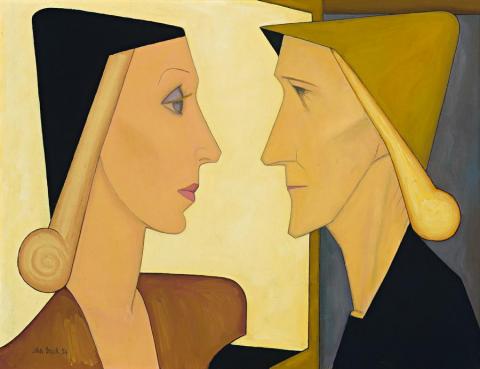WOMAN AND DUMMY, 1954
JOHN BRACK
oil on canvas
51.0 x 66.0 cm
signed and dated lower left: John Brack 54
Peter Bray Gallery, Melbourne
Dr Ursula Hoff, Melbourne
Christie's, Melbourne, 14 March 1972, lot 85
Private collection
Christie's, Sydney, 3 October 1973, lot 385
Private collection, Sydney
Nine Victorian Painters, Peter Bray Gallery, Melbourne, February 1954, cat. 6
John Brack: A Retrospective Exhibition, National Gallery of Victoria, Melbourne, 10 December 1987 – 31 January 1988
John Brack, National Gallery of Victoria, Melbourne, 24 April – 9 August 2009, Art Gallery of South Australia, Adelaide, 2 October 2009 – 26 January 2010 (label attached verso)
Art Notes, The Age, Melbourne, 24 February 1954, p. 2
Lindsay, R., John Brack: A Retrospective Exhibition, National Gallery of Victoria, Melbourne, 1987, p. 117
Grishin, S., The Art of John Brack, Oxford University Press, Melbourne, 1990, vol. I, p.44, vol. II, cat o28, pp. 5 and 90 (illus.)
Grant, K., John Brack, National Gallery of Victoria, Melbourne, 2009, pp. 34 and 213, (illus. p. 35)
John Brack's paintings of the fifties are so redolent of Melbourne of the time that they are treasured for their highly perceptive social commentary almost as much as great works of art. The two most outstanding are The Bar 1954, focusing on the serious six o'clock swill; and Collins Street, 5 PM 1955, the faces of the ordered ranks of workers as fixed as their homeward paths. Both these icons of Australian art are in the collection of the National Gallery of Victoria. Others, filled with metaphors of suburbia, continue to pull back the discreet curtains of time. The New House 1953, shows the ordered lounge room with everything rightly in its place, crowned by a framed picture print of a Vincent van Gogh painting. The Barber's Shop 1952 reminds us that short back and sides required weekly visits to maintain respectability, all brilliantly matter-of-fact. Each is identified by a bland title, The Church 1954, The Car 1955, The Bathroom 1957, and so on, the visual documentation as precise as the title.
When Brack turned his eye to his family, titles were equally bland. Although his Portrait of Helen Brack 1954 (private collection, Melbourne), is one of his most intimate works, Helen observed, 'John did not want to sentimentalise motherhood, nor glamorise it " it is Life he's describing, the adult but unknowing young woman about to move into an unknown world.'1 Woman and Dummy was painted in the same year and likewise touches upon what lies ahead and the paths we chose. The pun in the title, however, is pungent. The sharp-featured mature faced woman represents experience looking at youthful naivety. Similarities of hairstyles and hats, fashionably elongated in the shop dummy, establish a link between the two, contrasting artificiality with reality. The face of the model is ageless, that of the woman is lined. Glamorously shaded eyelids and dreamy eyes are compared with the penetratingly sharp, this contrast continued in the choice of colours. When commenting recently on this painting, Helen Brack said 'any likeness to me is incidental'. She added that 'John was very struck by female innocence'.2 In Woman and Dummy Brack explores female innocence and experience, the older woman looking into the window of artificiality, of fantasy versus reality, devoid of any sentimentality. The Bracks married in 1948, the autobiographical in his paintings being understandably pronounced during the following years. In our painting Brack, from an all male background, observes and explorers the female understanding heightened by a growing all female family. Woman and Dummy comes from the collection of the legendary Dr Ursula Hoff, once of the National Gallery of Victoria and an early and ongoing admirer of Brack's work. Significantly, she purchased it from the same 1954 exhibition at the Peter Bray Gallery that included Brack's drawing, Portrait of Dr Ursula Hoff, also of that year.
1. Helen Brack, quoted in Grant, K., John Brack, National Gallery of Victoria, Melbourne, 2009, p. 108
2. Email from Helen Brack, 27 July 2011
DAVID THOMAS
